2018年上海牛津沪教版六年级下册英语全册教案教学设计
沪教版本小学六年级的英语下教学设计课件课件

最新沪教版六年级英语下教学设计M1 Changes and differencesUnit1 You and me教学内容与目标教学内容功描述,询问● 询问身高及体重。
能● 描述差异语核心句型和●I ’m 150 centimeters tall.言日常用语●I usually play football after school.知●There are a lot of tall buildings in the city.识●How exciting!●That ’s fantastic!词汇Weigh, kilogram, centimeter,fan, theatre, go fishing,enjoyoneself语音a, a-e, ai, ay, eigh, i, i-e, y, igh,ie语听● 听懂谈论彼此身高体重和课余生活的对话。
言说● 用恰当的句型说说自己的身高、体重,介绍自己的课余生活技●用 There be 句型说说自己居住的环境。
能读● 读懂关于彼此身高、体重及课余生活差异的对话。
● 读懂关于城市与乡村差异的短文。
写● 能结合语境用正确的句子写写个人情况和生活环境。
教学目标● 能在语境中正确运用本单元的核心词汇,复习已学过的核心词。
● 能用用恰当的句型说说自己的身高、体重,介绍自己的课余生活,说说自己居住的环境●根据字母 a, a-e, ai, ay, eigh, i, i-e, y, igh,ie的发音规律,能拼读简单的单词。
● 能理解和尊重来自不同文化背景的人。
教学重点:●词汇: Weigh, kilogram, centimeter, fan, theatre, go fishing, enjoy oneself●句型: I ’m 150 centimeters tall. I usually play football after school.There are a lot of tall buildings in the city. How exciting! That’s fantastic!●字母 a, a-e, ai, ay, eigh, i, i-e, y, igh,ie教学点:一般在 be 、 do 和there be 在中的音。
【沪教牛津版(三起)】六年级下册英语教案Unit3Our-school-in-the-future
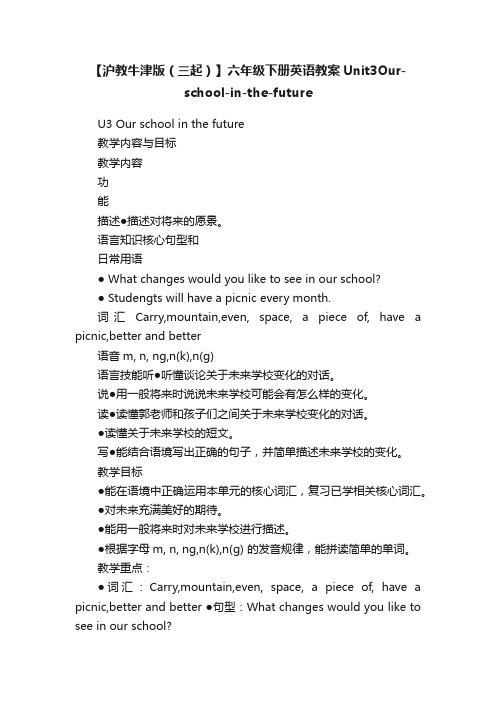
【沪教牛津版(三起)】六年级下册英语教案Unit3Our-school-in-the-futureU3 Our school in the future教学内容与目标教学内容功能描述●描述对将来的愿景。
语言知识核心句型和日常用语● What changes would you like to see in our school?● Studengts will have a picnic every month.词汇Carry,mountain,even, space, a piece of, have a picnic,better and better语音m, n, ng,n(k),n(g)语言技能听●听懂谈论关于未来学校变化的对话。
说●用一般将来时说说未来学校可能会有怎么样的变化。
读●读懂郭老师和孩子们之间关于未来学校变化的对话。
●读懂关于未来学校的短文。
写●能结合语境写出正确的句子,并简单描述未来学校的变化。
教学目标●能在语境中正确运用本单元的核心词汇,复习已学相关核心词汇。
●对未来充满美好的期待。
●能用一般将来时对未来学校进行描述。
●根据字母m, n, ng,n(k),n(g) 的发音规律,能拼读简单的单词。
教学重点:●词汇:Carry,mountain,even, space, a piece of, have a picnic,better and better ●句型:What changes would you like to see in our school?Studengts will have a picnic every month.●根据字母m, n, ng,n(k),n(g) 的发音规律,能拼读简单的单词。
教学难点:● will be 和 will do 的用法区别。
M1 Changes and differencesU3 Our school in the futurePeriod1教学目标[知识目标]1.通过Look and learn 复习动词词组2.通过Listen and say的学习,学习词汇和词组,复习使用一般将来时,谈论对未来学校的憧憬。
六年级英语下册 6B Module4 Unit1(1)教案 沪教牛津版
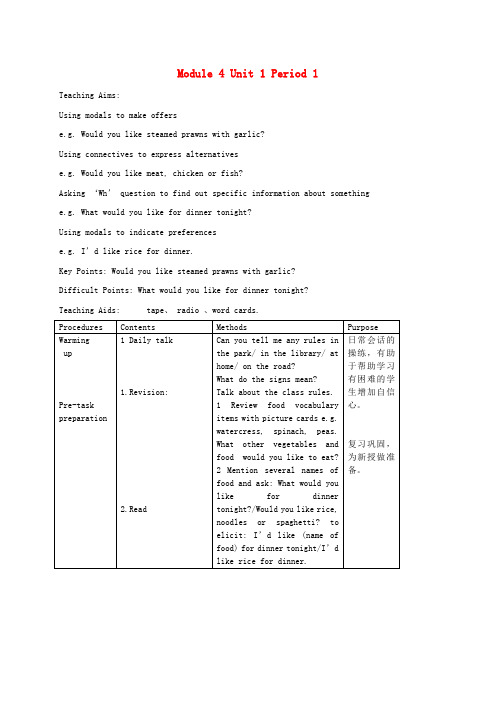
复习巩固,为新授做准备。
While-task procedure
Post-task activities
Assignment
1. The Li family’s dinner menu.
2. Mrs Li’s shopping list
1.Exercises
e.g. Would you like meat, chicken or fish?
Asking ‘Wh’ question to find out specific information about something
e.g. What would you like for dinner tonight?
3 Tell students that Mrs Li is going to do some shopping for tonight’s dinner, and that she has only rice and ice-cream at home. Students remain in their own groups to complete Mrs Li’s shopping list.
4 To check the answers with students, draw the shopping list on the board and invite a representative from each group to write an item on the list.
What would you like for dinner?
Using modals to indicate preferences
2018年下学期牛津上海版英语六年级下册全册教案

2018年下学期牛津上海版英语六年级下册全册教案Unit 1 Great cities in Asia一、单元分析(Unit Analysis)(一)单元地位(Unit Position)1 本课中出现了较多的特殊疑问句,用来询问。
询问方式,如How are we going to get to…?询问做某事花费时间的长度,如How long does it take?询问距离,如How far is it from … to …?询问方位,如Where…?这些问句及其答句,教师有必要在课堂教学中加以一定的机械性训练。
2在6A的同名模块中,学生已学习过How…? / How long…? 等特殊疑问句的表达方式。
已学习了用It takes sb. some time to do sth.的句型来回答做某事花费某人多少时间。
本unit中增加了疑问句“How far…?”。
建议温故知新,加以区分疑问词的意思及答句的不同方式。
3教授east, south, west, north四个方位,建议用指南针图表形式复习并学习其他四个方向,如north-east, south-east, south-west, north-west.4情态动词shall的用法在本课中多次出现,在课本中也为首次出现。
课文中主要结合旅行的方式提问。
教师可以设计多个场景,穿插各种不同的事物让学生进行操练。
5What …?/Which…?的句型最初在6A中就已出现。
本课中用来表示询问相关信息。
(二)单元目标(Unit Target)1 运用How far…?/ How long…?来询问距离及做某事花费时间的长度,并学会用It isabout…kilometers./It takes about…minutes.句式来回答。
2 掌握V+doing. 如love eating/enjoy swimming.3 操练有关How/Wh-的各种提问及其回答。
沪教版牛津英语六年级下册 下半学期U6-U10教学设计
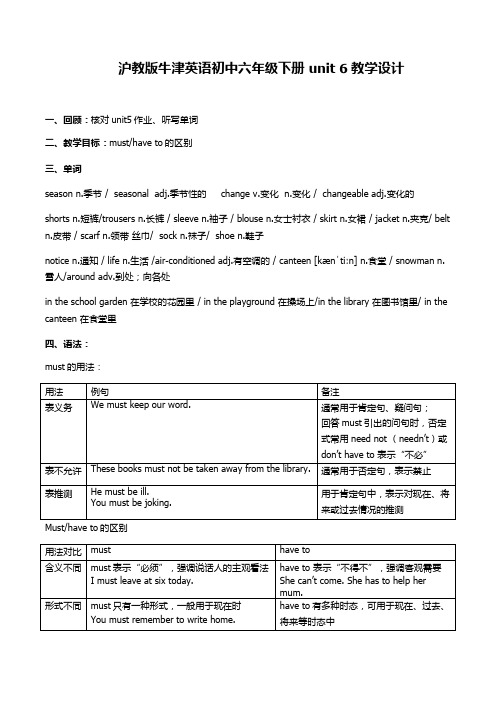
沪教版牛津英语初中六年级下册 unit 6教学设计一、回顾:核对unit5作业、听写单词二、教学目标:must/have to的区别三、单词season n.季节 / seasonal adj.季节性的 change v.变化 n.变化 / changeable adj.变化的shorts n.短裤/trousers n.长裤 / sleeve n.袖子 / blouse n.女士衬衣 / skirt n.女裙 / jacket n.夹克/ belt n.皮带 / scarf n.领带丝巾/ sock n.袜子/ shoe n.鞋子notice n.通知 / life n.生活 /air-conditioned adj.有空调的 / canteen [kænˈtiːn] n.食堂 / snowman n.雪人/around adv.到处;向各处in the school garden 在学校的花园里 / in the playground 在操场上/in the library 在图书馆里/ in the canteen 在食堂里四、语法:must的用法:Must/have to的区别五、作业:1.背诵单词、下次课听写;2.完成课后作业沪教版牛津英语初中六年级下册 unit 7教学设计一、回顾:核对unit6作业、听写单词二、教学目标:不定代词的形式和用法三、单词traval V.旅行 travelling n.交通 traveller n.旅行者Travelling in Shanghai will be more and more convenient.The Bund attracts many travelers to take photos there.public adj.平民的;大众的 n.平民;百姓 in public 公开地;当众 publicly adv.当众地,公开地→publish v 出版;发行;发表;刊登 publishing /published/publishedtransport n.交通运输系统;交通车辆;旅行方式 v.(用交通工具)运输、运送、输送、传播transportation n.交通;运输 a public transportation card 一张交通卡taxi/bus/train/car/plane/bicycle/motocyle摩托车/ferry轮船/light rail轻轨/underground地铁conduct v.指挥,进行 conductor n.售票员The manager asked him conduct the meeting.collect v.收集 collection n.收集Mr. Grey is interested in art and he has a large collection of painting.drive v.驾驶 driver n.司机My father drives me to school every day.cross v.穿过 across prep. 横过;在…对面 crossing n.十字路口Don’t cross the road when the traffic light is red.The old lady was walking across the road carefully.discuss v.讨论 discussion n.讨论We had discussion on language and communication.condition n.状态;状况 air-conditioned adj.有空调设备的 air-conditioner n.空调He’s going to install air-conditioner in the house.park v. 停车 park n.公园/停车库 car park 停车场fare n.票价、车费、船费 fare box 投币箱deck n.甲板;一层、层面 decker n.层;有…层的东西 single-decker n.单层车 double-decker n.双层车pave v.(用砖石)铺(地) paving/paved/paved pavement n.人行道railway n.铁路 tunnel n.隧道bridge footbridge n.人行桥 flyover n.立交桥post v.寄;邮寄;投递 n. 邮政;邮寄; posting/posted/posted poster n.招贴画;海报traffic lights 交通灯 traffic jam 交通拥堵四、语法:不定代词的形式:指代名词和形容词不定代词的语法功能1.作主语:Someone is asking to see you.2.作表语:That is all I have to say.3.作宾语:I know nothing about this person.4.作定语:If you have any question,please ask me.大多数不定代词都能作主语、宾语、表语或定语,但是代词none以及由some,any,no和every构成的复合不定代词只能作主语、宾语或表语,不能做定语。
六年级英语下册 6B Module2 Unit1(2)教案 沪教牛津版

Procedቤተ መጻሕፍቲ ባይዱres
Contents
Methods
Purpose
Warming
up
Pre-task preparation
1.Reading
2.Daily talk:
1.Revision:
2. Birthday cards
Ps
1.photocopiable page 38
Make a birthday card for one of their relatives.
1. Look and say.
2 .Copy the new words.
3.Make some birthday cards.
通过图示让学生清楚明白nephew,niece,cousin,grandson,granddaughter等生词的确切含义。
2.In pairs, the students match the birthday cards toAlice’s relatives.
3.In pairs, the students take turns to complete Eddie’s birthday cards. They should insert Eddie’s family roles. Invite different pairs to report back to rest of the class.
日常会话的操练,有助于帮助学习有困难的学生增加自信心。
复习巩固,为新授做准备。
出示生日卡片,激发学生学习兴趣。
While-task procedure
Post-task activities
沪教版六年级英语下教学设计
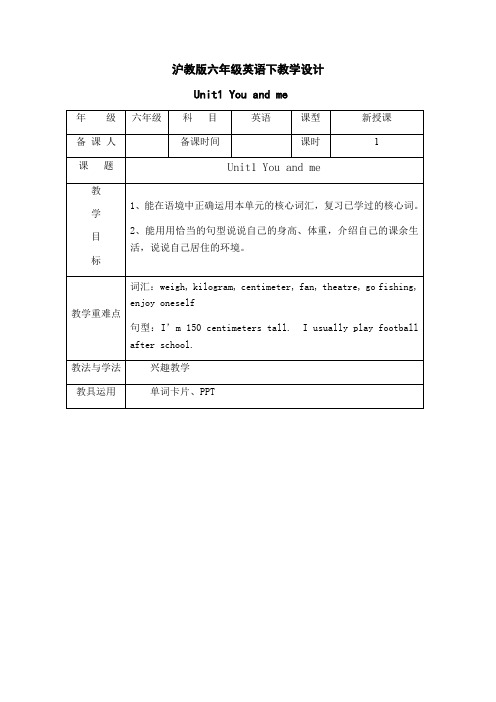
Height (cm)
Weight( kg)
S1: How tall are you ?
S2: I am hundred and forty-sixcentimeterstall. (S1 writes 146 in the table)
S1: How much do you weigh?
S2:Iweigh forty kilograms .(S1 write 40 in the table)
Iam fifty-nine kilograms .How much do you weigh?
T:Iknow you are one hundred and sixty-twocentimeterstall. But how tall amI? Do you remember?
S1:You are one hundred and sixtycentimeterstall.
T:How tall are you?
S1:Iam one hundred and fifty-ninecentimeterstall.
T: How tall are you ?
S2:Iam one hundred and sixty-twocentimeterstall.
3、教师顺着上述活动中最近一个学生话语引出句型:
Look at…he’s one hundred and fiftycentimeterstall.Iam one hundred and seventycentimeterstall.SoIam taller.
然后分别请两个高矮不一的学生站起来,教师问:Who is taller?请全班学生回答:
S1: It’s one hundred and sixty.
沪教版小学英语六年级下册全册教案
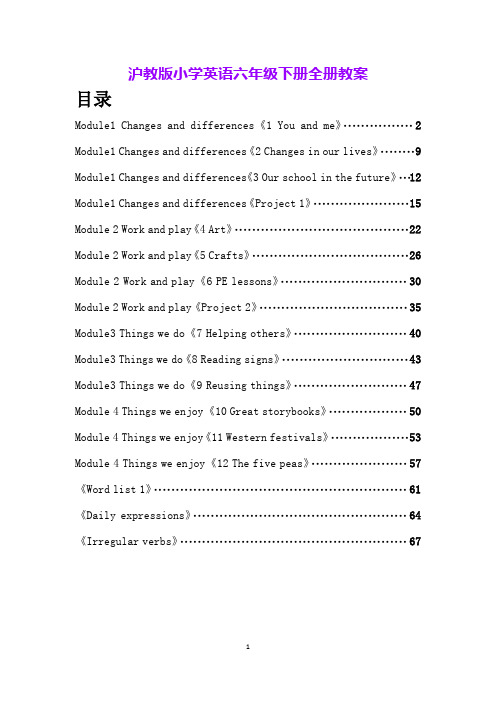
沪教版小学英语六年级下册全册教案目录Module1 Changes and differences《1 You and me》 (2)Module1 Changes and differences《2 Changes in our lives》 (9)Module1 Changes and differences《3 Our school in the future》 (12)Module1 Changes and differences《Project 1》 (15)Module 2 Work and play《4 Art》 (22)Module 2 Work and play《5 Crafts》 (26)Module 2 Work and play《6 PE lessons》 (30)Module 2 Work and play《Project 2》 (35)Module3 Things we do《7 Helping others》 (40)Module3 Things we do《8 Reading signs》 (43)Module3 Things we do《9 Reusing things》 (47)Module 4 Things we enjoy《10 Great storybooks》 (50)Module 4 Things we enjoy《11 Western festivals》 (53)Module 4 Things we enjoy《12 The five peas》 (57)《Word list 1》 (61)《Daily expressions》 (64)《Irregular verbs》 (67)Module1 Changes and differences《1 You and me》1教学目标1、能简单询问别人的长相,以及相关的具体个人信息,并能进行比较。
例如:What’s …like? How tall are you? How hea vy are you? How old are you?How long…? How bi g…?2、能听懂会说: I’m…than …. My …than your s…My …kg...My…cm long.等句子,并能在实际情景中运用。
六年级英语下册 6B Module2 Unit1(1)教案 沪教牛津版
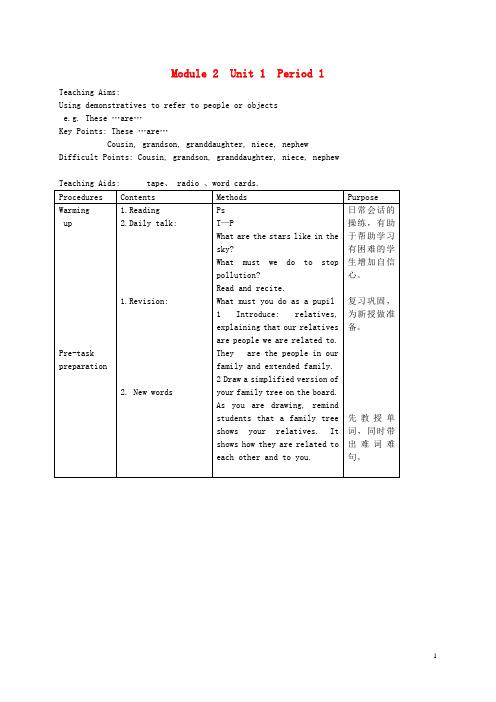
Who’s your father’s brother?
Who’syourgrandmother’s husband?
Look and say: Who are these people?
He’s/She’sAlice’s father/brother/sister/cousin/uncle/aunt
日常会话的操练,有助于帮助学习有困难的学生增加自信心。
复习巩固,为新授做准备。
先教授单词,同时带出难词难句。
While-task procedure
Post-task activities
Assignment
relationship of family members
2. Look and learn.
1.Reading
2.Daily talk:
1.Revision:
2. New words
Ps
T—P
What are the stars like in the sky?
What must we do to stop pollution?
Read and recite.
What must you do as a pupil
Module 2Unit 1Period 1
Teaching Aims:
Using demonstratives to refer to people or objects
e.g. These …are…
Key Points: These …are…
Cousin, grandson, granddaughter, niece, nephew
These are our grandsons.
上海六年级牛津英语下册教案范文集锦

上海六年级牛津英语下册教案范文集锦全面贯彻“三个面向”战略指导思想,渗透和灌输可持续发展的战略思想。
以素质教育为根本宗旨,以培养创新精神和实践能力为重点,充分发挥学生的潜能,提高学生的全面素质和自学能力。
那么在学习英语的过程中有哪些教案会比较好呢?以下是小编带来的上海六年级牛津英语下册教案内容,感谢您的阅读,希望能帮助到您!上海六年级牛津英语下册教案1Unit 1 Who is younger?一、语音:ir字母组合在单词中的发音 /E:/二、单词和习惯用语: (共21个)四会单词和习惯用语(9个):young年轻的 go for a walk 去散步 glad 高兴的,乐意的as…as 和……一样 tall高的 than比 short短的、矮的 strong 强壮的 heavy 重的三会单词(10个):chat聊天 light轻的 sit(sat)坐 meet(met)遇见、见面 twin (双胞胎)之一 as作为 minute分钟 only惟一的、仅有的 child孩子(children 孩子们)centimeter 厘米二会单词(2个): height身高 weight体重三、词组:1.on Sunday morning 在星期天早晨2.go for a walk 去散步3. look the same 看起来一样4.as tall as 与…..一样高 as fat as 与…..一样胖as long as 与….一样长5. shorter than 比….矮bigger than比大heavier than比重6. twenty minutes younger小二十分钟7.one year older大一岁9.be glad to do 非常高兴做某事10.a twin sister 双胞胎姐妹11.how old 多大12.the only child 仅有的一个孩子13.a tall boy 一个高个子的男孩14.a young teacher 一位年轻的教师15.some heavy boxes 一些重的盒子16.your old friend(s)你的老朋友17.a strong goalkeeper 一个强壮的守门员18.the girl in red 穿红衣服的女孩19.yours or mine 你的还是我的20.look young 看起来年轻21.have a chat 聊天、闲谈四、形容词比较级:A.直接加er/rtall---________light----________young--_________old---________strong--___ small--_________late---_________long---_________short--________ nice--- _____B.双写加erbig-------_________ fat-----_________ thin---________ hot---________C.去y改i加erheavy---_________ early---__________ busy---__________D不规则good---_______ many---________ much---______ bad/ill ---_____ little---_______五、句型:1、A+谓语(be动词)+形容词比较级+than +B A比B……Who’s younger than him ? 谁比他年轻?My brother is younger than him . 我弟弟比他年轻。
牛津版上海版六年级下册 Unit 5 What will I be like 教学设计

牛津版上海版六年级下册 Unit 5 What will I be like 教学设计一. 教材分析牛津版上海版六年级下册Unit 5的主题是“What will I be like”,通过本单元的学习,学生将能够预测自己将来的外貌、性格和生活,并能够用一般将来时进行表达。
本单元的主要语言点包括一般将来时的构成(will + 动词原形)、外貌、性格和生活方式的描述词汇以及相关交际用语。
二. 学情分析六年级的学生已经掌握了英语学习的基本语法和词汇,对于一般将来时的概念也有了一定的了解。
学生具备一定的听说读写能力,能够进行简单的交际。
然而,部分学生可能在表达自己的预测时存在一定的困难,需要教师给予一定的引导和鼓励。
三. 教学目标1.知识目标:学生能够掌握一般将来时的构成和用法,学会用英语描述自己的外貌、性格和生活方式。
2.能力目标:学生能够在真实情境中运用所学语言进行交际,提高口语表达能力。
3.情感目标:学生能够激发对未来的憧憬和探索欲望,培养积极的人生态度。
四. 教学重难点1.重点:一般将来时的构成和用法,外貌、性格和生活方式的描述词汇。
2.难点:如何运用所学语言进行真实的交际,表达自己的预测。
五. 教学方法1.任务型教学法:通过设计各种交际任务,让学生在实践中学习和运用语言。
2.情境教学法:创设真实的情境,激发学生的学习兴趣和积极性。
3.合作学习法:鼓励学生进行小组合作,培养学生的团队精神和交际能力。
六. 教学准备1.教学课件:制作与本单元主题相关的课件,包括图片、视频等素材。
2.教学道具:准备一些与外貌、性格和生活方式相关的小道具,如眼镜、帽子等。
3.练习题:设计一些练习题,用于巩固所学知识。
七. 教学过程1.导入(5分钟)利用图片或视频展示一些未来的场景,引导学生思考未来的自己会是什么样子。
例如,可以展示一些未来的职业、科技发展的场景。
2.呈现(10分钟)教师通过展示一些与外貌、性格和生活方式相关的小道具,引导学生用英语描述自己的预测。
2018牛津上海版六下Unit 5《What will I be like》word教案1

2018牛津上海版六下Unit 5《What will I belike》word教案1单元分析(Unit Analysis)(一)单元地位(Unit Position)1 本课中重点学习了“He/She/You will be____ centimeters taller./___ _____ kilogrammes heavier.”“He/She/You will be____ and_____.”“H e’ll/She’ll/You’ll possibly be a/an _____.”等使用一样今后时来叙述今后事实的句型.一样今后时在前面的课文中差不多学过,但在课文中增加了与现在的一个比较,还要进一步的进行巩固性操练。
2 be good at sth/doing sth 的用法在本册书本Module One, Unit Three 的课文中显现过,在本单元中大量使用,同时新增了反义词组be poor at st h/ doing sth 的使用. 教师可通过咨询题化设计,让学生进行操练并把握.3 用First, Next, Then, Finally等副词来表示时刻顺序在6A中被介绍使用过,在本课中让学生进一步巩固复习。
4 在本单元中涉及的有关工作的词汇,建议以旧带新,在复习的基础上把握新的内容。
(二)单元目标(Unit Target)1 运用情态动词have to来表示在客观要求下不得不做某事。
如I have to practise English and Chinese more. / I have to learn to make sick pe ople better.2 运用固定表达Yes, I agree. /No, I don’t agree. 来表达意见。
如P eter will possibly be a policeman. Yes, I agree. /No, I don’t agree. I thi nk he’ll possibly be a fireman.3 操练有关今后外貌、喜好、职业的各种提咨询和对话。
沪教牛津版六年级下册英语教学设计5篇
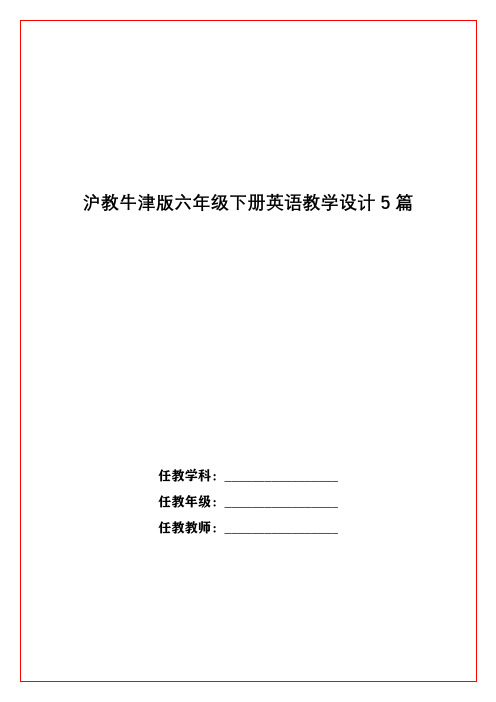
T: Look, what did David do on Sunday? (PPT2显示David 在看卡通片)
T: Yes, he watched cartoons. What else did he do ?
(PPT显示David在走向动物园,稍停,等待回答)
T: Now practice in pairs. (PPT3 显示一个男孩和一个女孩的活动,图下有时间和句型)
首先, 这是一个掷筛子的游戏,请根据图片顺序来解释一下游戏规则。
(PPT24--25 显示图片)
(学生尝试解释游戏规则)
2 T: 游戏规则就是象大家所描述的这样:
首先第一个同学根据所掷筛子的数字走棋子,并向第二个同学提问,如果第二个同学答对了就换成第二个同学掷筛子提问;如果答错了,第一个同学进行纠正,并继续掷筛子。
(稍等)
引导学生使用句型: Whose… is it/are they? It’s /They’re mine/his/hers/ours.
造句。复习第七单元名词性物主代词的用法。
(本步骤设计说明:本单元是综合复习,在本部分,教师安排对话、交流等形式复习旧知,为本课练习做铺垫。)
第二步:单元各板块综合练习
3 (出示PPT14--16核对正确答案,讲解易错部分)
(三) C Look, read and complete
1 T:刚才,我们练习的都是口头表达,下面我们来试试书面表达. Look!
(PPT17--19 显示各个单元重点句式中容易出错的地方,需要强调之处均为空白; 在引导学生自主归纳的基础上,出示PPT完整内容)
T: We know we can get some presents on Christmas day. And last year, on
六年级英语下册 6B Module1 Unit4(4)教案 沪教牛津版

3 Invite some students to read out their report to the class and show their illustration.
4 Bind the reports into a class book called ‘The night sky’.
1.Discribe the stars.
1. Read and recite the poem.
2 .Copy the new words.
3.Make a new poem.
说说做做练练中,让学生掌握关键句型。
e.g. What can you see?
Key Points: What can you see?
Watching us and winking.
Difficult Points: Watching us and winking.
Teaching Aids:tape、 radio 、word cards.
Procedures
Contents
Methods
Purpose
Warming
up
Pre-task preparation
1.Reading
2.Daily talk:
1.Revision:
2. New words
Ps
T—P
WhenHale Waihona Puke can we see the Sun?
沪教版本小学六年级的英语下精品教学设计课件
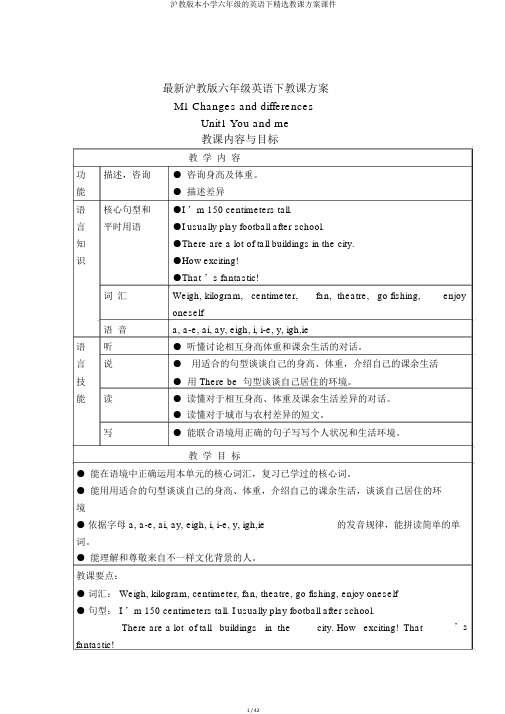
最新沪教版六年级英语下教课方案M1 Changes and differencesUnit1 You and me教课内容与目标教学内容功描述,咨询● 咨询身高及体重。
能● 描述差异语核心句型和●I ’m 150 centimeters tall.言平时用语●I usually play football after school.知●There are a lot of tall buildings in the city.识●How exciting!●That ’s fantastic!词汇Weigh, kilogram, centimeter, fan, theatre, go fishing, enjoy oneself语音a, a-e, ai, ay, eigh, i, i-e, y, igh,ie语听● 听懂讨论相互身高体重和课余生活的对话。
言说● 用适合的句型谈谈自己的身高、体重,介绍自己的课余生活技●用 There be 句型谈谈自己居住的环境。
能读● 读懂对于相互身高、体重及课余生活差异的对话。
● 读懂对于城市与农村差异的短文。
写● 能联合语境用正确的句子写写个人状况和生活环境。
教学目标● 能在语境中正确运用本单元的核心词汇,复习已学过的核心词。
● 能用用适合的句型谈谈自己的身高、体重,介绍自己的课余生活,谈谈自己居住的环境●依据字母 a, a-e, ai, ay, eigh, i, i-e, y, igh,ie 的发音规律,能拼读简单的单词。
● 能理解和尊敬来自不一样文化背景的人。
教课要点:●词汇: Weigh, kilogram, centimeter, fan, theatre, go fishing, enjoy oneself●句型: I ’m 150 centimeters tall. I usually play football after school.There are a lot of tall buildings in the city. How exciting! That ’s fantastic!●字母 a, a-e, ai, ay, eigh, i, i-e, y, igh,ie教课点:一般在 be 、 do 和there be 在中的音。
- 1、下载文档前请自行甄别文档内容的完整性,平台不提供额外的编辑、内容补充、找答案等附加服务。
- 2、"仅部分预览"的文档,不可在线预览部分如存在完整性等问题,可反馈申请退款(可完整预览的文档不适用该条件!)。
- 3、如文档侵犯您的权益,请联系客服反馈,我们会尽快为您处理(人工客服工作时间:9:00-18:30)。
Module 1 Changes and difference Unit 1 You and me Period one
教学目标
1. 能听、说、读、写重点单词重,能运用重点句型描述自己及他人的身高、体重,并进行
问答。
2. 能运用there be 句型描述城市与乡村的景物。
3. 培养孩子们在实际情境中运用目标语言交流的热情和能力,保持学习英语的积极态度和信心。
教学重、难点
Words: weight kilogram centimetre fan theater
Sentences: How old are you ? I’m... centimetres tall. How much do you weigh ? I weigh ... Kilograms
教学准备Recorder
教学过程
Step One: Warming up
1. Greeting
2. Free talking ( 直接引入新知)
T: Ma Rong is the tallest in our class ,yes ?
S: Yes!
T: How tall?
S: 160
the blackboard )
T:So tall ! 160 centimetres tall ( Show “centimetrestall”on
Step Two: New lesson
T: Ma Rong is 160 centimetres tall . What about Sheng Li ?
S: 120 centimetres tall.
T: How much does he weigh ? ( 多高?)
S: 35
T: 35 kilograms ( Show “35kilograms”
on the blackboard )
1. Show PPT to children
T: How tall is Peter ?。
